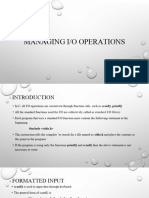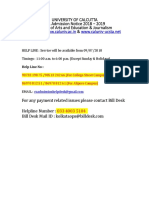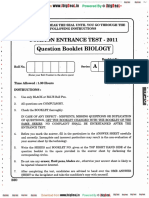C - Code Examples
Uploaded by
Soumodip ChakrabortyC - Code Examples
Uploaded by
Soumodip ChakrabortyProgram to Display "Hello, World!
"
#include <stdio.h>
int main()
{
// printf() displays the string inside quotation
printf("Hello, World!");
return 0;
}
Output
Hello, World!
How "Hello, World!" program works?
The #include <stdio.h> is a preprocessor command. This command tells
compiler to include the contents of stdio.h (standard input and output) file in the
program.
The stdio.h file contains functions such as scanf() and print() to take input and
display output respectively.
If you use printf() function without writing #include <stdio.h>, the program will
not be compiled.
The execution of a C program starts from the main() function.
The printf() is a library function to send formatted output to the screen. In this
program, the printf() displays Hello, World! text on the screen.
The return 0; statement is the "Exit status" of the program. In simple terms,
program ends with this statement.
Program to Print an Integer
#include <stdio.h>
int main()
{
int number;
// printf() dislpays the formatted output
printf("Enter an integer: ");
// scanf() reads the formatted input and stores them
scanf("%d", &number);
// printf() displays the formatted output
printf("You entered: %d", number);
return 0;
}
Output
Enter a integer: 25
You entered: 25
In this program, an integer variable number is declared.
The printf() function displays Enter an integer: on the screen. Then,
the scanf()function reads an integer data from the user and stores in variable number.
Finally, the value stored in the variable number is displayed on the screen
using printf()function.
Program to Add Two Integers
#include <stdio.h>
int main()
{
int firstNumber, secondNumber, sumOfTwoNumbers;
printf("Enter two integers: ");
// Two integers entered by user is stored using scanf() function
scanf("%d %d", &firstNumber, &secondNumber);
// sum of two numbers in stored in variable sumOfTwoNumbers
sumOfTwoNumbers = firstNumber + secondNumber;
// Displays sum
printf("%d + %d = %d", firstNumber, secondNumber, sumOfTwoNumbers);
return 0;
}
Program to Multiply Two Numbers
#include <stdio.h>
int main()
{
double firstNumber, secondNumber, productOfTwoNumbers;
printf("Enter two numbers: ");
// Stores two floating point numbers in variable firstNumber and
secondNumber respectively
scanf("%lf %lf", &firstNumber, &secondNumber);
// Performs multiplication and stores the result in variable
productOfTwoNumbers
productOfTwoNumbers = firstNumber * secondNumber;
// Result up to 2 decimal point is displayed using %.2lf
printf("Product = %.2lf", productofTwoNumbers);
return 0;
}
Output
Enter two numbers: 2.4
1.12
Product = 2.69
In this program, user is asked to enter two numbers. These two numbers entered by the
user is stored in variable firstNumber and secondNumber respectively. This is done
using scanf() function.
Then, the product of firstNumber and secondNumber is evaluated and the result is
stored in variable productOfTwoNumbers.
Finally, the productOfTwoNumbers is displayed on the screen using printf() function.
Notice that, the result is round to second decimal place using %.2lf conversion
character.
Program to Print ASCII Value
#include <stdio.h>
int main()
{
char c;
printf("Enter a character: ");
// Reads character input from the user
scanf("%c", &c);
// %d displays the integer value of a character
// %c displays the actual character
printf("ASCII value of %c = %d", c, c);
return 0;
}
Output
Enter a character: G
ASCII value of G = 71
In this program, user is asked to enter a character which is stored in variable c. The
ASCII value of that character is stored in variable c rather than that variable itself.
When %d format string is used, 71 (ASCII value of 'G') is displayed.
When %c format string is used, 'G' itself is displayed.
You might also like
- Introduction To C Programming: R. Jothi Scope VitNo ratings yetIntroduction To C Programming: R. Jothi Scope Vit22 pages
- Introduction To Input Output in C Programming-1No ratings yetIntroduction To Input Output in C Programming-136 pages
- Lab Report On C-Programming Lab No.: 1 To 12 Title: Introduction and Variables Date: 2079/01/16No ratings yetLab Report On C-Programming Lab No.: 1 To 12 Title: Introduction and Variables Date: 2079/01/16199 pages
- C Programming - 24aiu1cp Sample ProgramsNo ratings yetC Programming - 24aiu1cp Sample Programs3 pages
- CS 111 Introduction To Computer Science: by Wessam El-Behaidy & Amr S. GhoneimNo ratings yetCS 111 Introduction To Computer Science: by Wessam El-Behaidy & Amr S. Ghoneim31 pages
- Csc181 1 - Introduction To C ProgrammingNo ratings yetCsc181 1 - Introduction To C Programming27 pages
- Grade-9-Introduction-to-C-Programming (1)No ratings yetGrade-9-Introduction-to-C-Programming (1)12 pages
- CS 414/415 Section C For Java Programmers: Indranil GuptaNo ratings yetCS 414/415 Section C For Java Programmers: Indranil Gupta47 pages
- CSE 021 - Lec04 - Input, Proc., Output - 16.11.21No ratings yetCSE 021 - Lec04 - Input, Proc., Output - 16.11.2137 pages
- PG Admission Notice (For College Principal/TIC Only)No ratings yetPG Admission Notice (For College Principal/TIC Only)1 page
- University of Calcutta P.G. Admission Notice 2018 Faculty of Arts and Education & Journalism Website: &No ratings yetUniversity of Calcutta P.G. Admission Notice 2018 Faculty of Arts and Education & Journalism Website: &1 page
- Nondeterministic Finite Automata (NFA) : Multiple Next StateNo ratings yetNondeterministic Finite Automata (NFA) : Multiple Next State4 pages
- Basic Environmental Engineering & Elementary Biology Syllab PDFNo ratings yetBasic Environmental Engineering & Elementary Biology Syllab PDF2 pages
- Regular Grammars: Theorem: A Language L Is Regular Iff It Has A Regular Grammar. We Use The Following TwoNo ratings yetRegular Grammars: Theorem: A Language L Is Regular Iff It Has A Regular Grammar. We Use The Following Two6 pages
- Lecture 6: Divide and Conquer and Mergesort: (Thursday, Feb 12, 1998)No ratings yetLecture 6: Divide and Conquer and Mergesort: (Thursday, Feb 12, 1998)4 pages
- PHYSICS - 1 (PH 191 & PH 291) - Practical Manual-2No ratings yetPHYSICS - 1 (PH 191 & PH 291) - Practical Manual-254 pages
- Full Length Model Paper Wbut Semester 2 Engineering Mathematics M 201 GROUP A (Multiple Choice Type Questions)No ratings yetFull Length Model Paper Wbut Semester 2 Engineering Mathematics M 201 GROUP A (Multiple Choice Type Questions)3 pages
- Full Length Model Paper Wbut 2 Semester Chemistry - 1 CH 201 GROUP A (Multiple Choice Type Questions)No ratings yetFull Length Model Paper Wbut 2 Semester Chemistry - 1 CH 201 GROUP A (Multiple Choice Type Questions)3 pages
- Chapter-Wise Suggestion Paper: M201 MathematicsNo ratings yetChapter-Wise Suggestion Paper: M201 Mathematics6 pages
- Full download Air Empire British Imperial Civil Aviation 1919 39 1st Edition Gordon Pirie pdf docxNo ratings yetFull download Air Empire British Imperial Civil Aviation 1919 39 1st Edition Gordon Pirie pdf docx77 pages
- Chhattisgarh Swami Vivekanand Technical University, BhilaiNo ratings yetChhattisgarh Swami Vivekanand Technical University, Bhilai22 pages
- Lua Introduction For New Programmers: Download Slides atNo ratings yetLua Introduction For New Programmers: Download Slides at47 pages
- Agatha Christie - Hercule Poirot, Book 03, Poirot Investigates 003, The Adventure of The Cheap Flat (1924)No ratings yetAgatha Christie - Hercule Poirot, Book 03, Poirot Investigates 003, The Adventure of The Cheap Flat (1924)13 pages
- Introduction To DWR (Direct Web Remoting)No ratings yetIntroduction To DWR (Direct Web Remoting)73 pages
- Download full (Ebook) Interpersonal Perception, Second Edition: The Foundation of Social Relationships by David A. Kenny ISBN 9781462541515, 1462541518 ebook all chapters100% (1)Download full (Ebook) Interpersonal Perception, Second Edition: The Foundation of Social Relationships by David A. Kenny ISBN 9781462541515, 1462541518 ebook all chapters82 pages
- Dissertation Research and Writing For Construction Students Free PDF100% (1)Dissertation Research and Writing For Construction Students Free PDF7 pages
- Portfolio Optimization with Different Information Flow 1st Edition Edition Hillairet Caroline And Jiao Ying (Auth.) - Download the ebook now and read anytime, anywhere100% (1)Portfolio Optimization with Different Information Flow 1st Edition Edition Hillairet Caroline And Jiao Ying (Auth.) - Download the ebook now and read anytime, anywhere48 pages
- Qdoc - Tips - Cambridge-English-Advanced-2 (1) - 63-64No ratings yetQdoc - Tips - Cambridge-English-Advanced-2 (1) - 63-642 pages
- POSIX Threads Programming: Blaise Barney, Lawrence Livermore National LaboratoryNo ratings yetPOSIX Threads Programming: Blaise Barney, Lawrence Livermore National Laboratory36 pages
- Personal Identity 3rd Edition Harold W Noonan - Download the entire ebook instantly and explore every detail100% (1)Personal Identity 3rd Edition Harold W Noonan - Download the entire ebook instantly and explore every detail60 pages
- PDF Text, Cases and Materials On Contract Law 5th Edition Richard Stone Download100% (18)PDF Text, Cases and Materials On Contract Law 5th Edition Richard Stone Download49 pages
- Sotheby's Announces Two Major Highlights of Its Impressionist & Modern Art Evening Sale in New York - 6 November 2013No ratings yetSotheby's Announces Two Major Highlights of Its Impressionist & Modern Art Evening Sale in New York - 6 November 20136 pages





















































































































